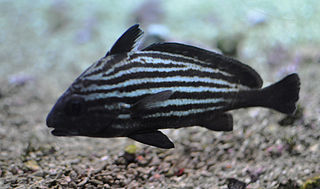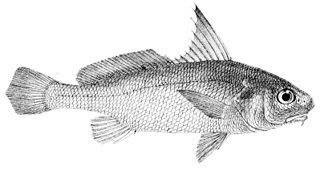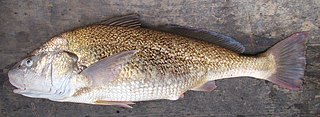
Sciaenidae is a family of ray-finned fishes belonging to the order Acanthuriformes. They are commonly called drums or croakers in reference to the repetitive throbbing or drumming sounds they make. The family consists of about 293 to 298 species in about 66 or 67 genera.

Menticirrhus is a genus of marine ray-finned fish belonging to the family Sciaenidae, the drums or croakers. They are commonly known as kingcroakers or kingfish. These fish are found in the Western Atlantic and Eastern Pacific Oceans.

Argyrosomus is a genus of marine ray-finned fishes belonging to the family Sciaenidae, the drums. The fish in this genus are large and are commonly targeted as game fish.

Micropogonias is a genus of marine ray-finned fishes belonging to the family Sciaenidae, the drums and croakers. These fishes are found in the eastern Pacific and western Atlantic Oceans.

Plagioscion is a genus of freshwater ray-finned fishes belonging to the family Sciaenidae, the drums and croakers. They are found in tropical and subtropical South America where they inhabit fresh and brackish waters. Some species are important food fish and support major fisheries.

Pseudotolithus is a genus of marine ray-finned fish belonging to the family Sciaenidae, the drums or croakers. The species in this genus are found in the Eastern Atlantic Ocean.

Cynoscion is a genus of marine ray-finned fishes belonging to the family, Sciaenidae, the drums and croakers. These fishes are found off the coasts of North and South America in the western Atlantic and eastern Pacific Oceans. Many fishes in this genus have been given the common name weakfish.

Pareques acuminatus, commonly known as the high-hat, donkeyfish, cubbyu, Steindachner's ribbonfish, streaked ribbonfish, striped ribbonfish or striped drum, is a species of marine ray-finned fish belonging to the genus Pareques in the family Sciaenidae, the drums and croakers. This species is found in the western Atlantic Ocean.

Sciaena is a genus of marine ray-finned fishes belonging to the family Sciaenidae, the drums and croakers. These fishes are found in the Eastern Pacific Ocean and the Eastern Atlantic Ocean.

Atractoscion is a genus of marine ray-finned fished belonging to the family Sciaenidae, the drums and croakers. The fishes in this genus are found in the Atlantic, Indian and Pacific Oceans.

Pareques is a genus of marine ray-finned fishes belonging to the family Sciaenidae, the drums and croakers. These fishes are found in the western Atlantic Ocean and eastern Pacific Ocean.

Johnius is a genus of marine ray-finned fishes belonging to the family Sciaenidae, the drums and croakers. They are commonly known as croakers due to their ability to produce purring, croaking and knocking sounds. The sounds are produced mainly at night and are thought to be either involved in defense or for courtship.

Odontoscion dentex, the reef croaker or brown large-eyed croaker, is a species of marine ray-finned fish belonging to the family Sciaenidae, the drums and croakers. It is found in coral and rocky reefs of the tropical Western Atlantic, living as solitary individuals or in small groups at a depth of 1 to 30 m. This species feeds on small fish, shrimp, and larvae.
Ctenosciaena is a genus of marine ray-finned fishes belonging to the family Sciaenidae, the drums and croakers. These fishes are found in the Western Atlantic and southeastern Pacific Oceans.

Micropogonias furnieri, the whitemouth croaker, golden croaker, hardhead, mangrove snapper, rocandoronco, two-belly bashaw, West Indian croaker, West Indian drum or whitemouth drummer, is a species of marine ray-finned fish belonging to the family Sciaenidae, the drums and croakers. This fish is found in the western Atlantic Ocean.

Odontoscion is a genus of marine ray-finned fish belonging to the family Sciaenidae, the croakers and drums. These fishes are found in the Western Atlantic and Eastern Pacific Oceans.

Pachyurus is a genus of freshwater ray-finned fishes belonging to the family Sciaenidae, the drums and croakers. The ten recognised species in the genus are found in South America.
Paralonchurus is a genus of marine ray-finned fishes belonging to the family Sciaenidae, the drums and croakers. These fishes are found in the eastern Pacific Ocean with one species in the western Atlantic Ocean.
Protosciaena is a small genus of marine ray-finned fishes belonging to the family Sciaenidae, the drums and croakers. These fishes are found in the Western Atlantic Ocean.

The boe drum is a species of marine ray-finned fish belonging to the family Sciaenidae, the drums and croakers. It is the only species in the monospecific genus Pteroscion. The boe drum is found in the eastern Atlantic Ocean off western coast of Africa.















